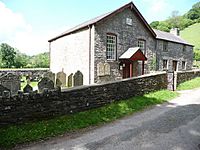Tabernacle Baptist Chapel, Cwmyoy facts for kids
Quick facts for kids Tabernacle Baptist Chapel |
|
|---|---|

Chapel and attached manse
|
|
| Lua error in Module:Location_map at line 420: attempt to index field 'wikibase' (a nil value). | |
| Location | Cwmyoy, Monmouthshire |
| Country | Wales |
| Denomination | Baptist |
| History | |
| Founded | 1837 |
| Architecture | |
| Heritage designation | Grade II* |
| Designated | 29 January 1998 |
| Architectural type | Chapel |
The Tabernacle Baptist Chapel is a special building located in Ffwthog, near Cwmyoy, in Monmouthshire, Wales. It is a Baptist chapel, which is a type of church. This chapel was built a long time ago, in 1837. It also has a house, called a manse, attached to it. The chapel looks almost exactly the same today as it did when it was first built. Because it is so well-preserved, it has a special protection status called a Grade II* listed building. This means it's a very important historical building.
The Chapel's Story
The Tabernacle Baptist Chapel was built in the year 1837. You can see this date carved into a stone tablet above the main entrance. The tablet also says "TABERNACLE Baptist Chapel ST. JT. Builders. 1837." The manse, which is the house for the minister, is connected right to the chapel.
What the Chapel Looks Like
An expert on buildings, John Newman, described the chapel as a "simple gable-ended building." This means it has a basic shape with a triangular wall at the end, like many houses. The chapel is built from Old Red Sandstone rubble, which are rough, natural stones. Its roof is made of Welsh slate, a common roofing material in Wales.
The front porch was added in the 1900s, but the main doors are still the original ones from 1837. Inside the chapel, there is a seating area called a gallery on three sides. This gallery is held up by strong cast iron pillars. Newman also noted that there were "long rows of hat-pegs" on both levels, which were used for people to hang their hats during services.

